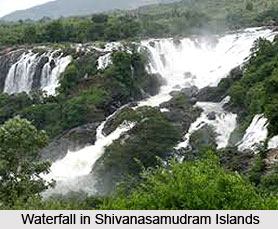 Shivanasamudram Islands are best known for its waterfalls with the same name Shivanasamudra Falls on the river Kaveri. Today, Shivanasamudram is a small town in the Mandya District of the state of Karnataka, India. It is situated on the banks of the river Kaveri and is the location of the second Hydro-electric Power station in Asia, which was set up in the year 1902.
Shivanasamudram Islands are best known for its waterfalls with the same name Shivanasamudra Falls on the river Kaveri. Today, Shivanasamudram is a small town in the Mandya District of the state of Karnataka, India. It is situated on the banks of the river Kaveri and is the location of the second Hydro-electric Power station in Asia, which was set up in the year 1902.
The Shivanasamudra Falls is on the Kaveri River after the river has wound its way through the rocks and ravines of the Deccan Plateau and drops off to create the waterfalls. The island town of Shivanasamudra divides the river into twin waterfalls. This creates the fourth largest island in the course of Kaveri River. A group of ancient temples are located in Shivanasamudram Island and boasts a cluster of urban sites.
Shivanasamudram Falls is a segmented waterfall. Segmented waterfalls occur where the water flow is broken into two or more channels before dropping over a cliff, resulting in multiple parallel waterfalls. It is a perennial waterfall and the falls can be seen at its best during the monsoon season of July to October. The two segments are called Gaganachukki and Bharachukki. The Bharachukki falls are a few kilometers to the southwest of the Gaganachukki falls and are two important tourist spots of Shivanasamudram Island. Shivanasamudram is 139km from the city of Bangalore.
Asia`s first hydroelectric power stations, still working is located at Shivanasamudram Falls. The Diwan of Mysore, Sir K. Seshadri Iyer, commissioned this station. The electricity produced here was initially used in the Kolar Gold Fields. Thus, Kolar Gold Fields became the first town in Asia to receive hydro electricity. Shivanasamudram is one of the most productive towns in south India for various small scale industries.



















